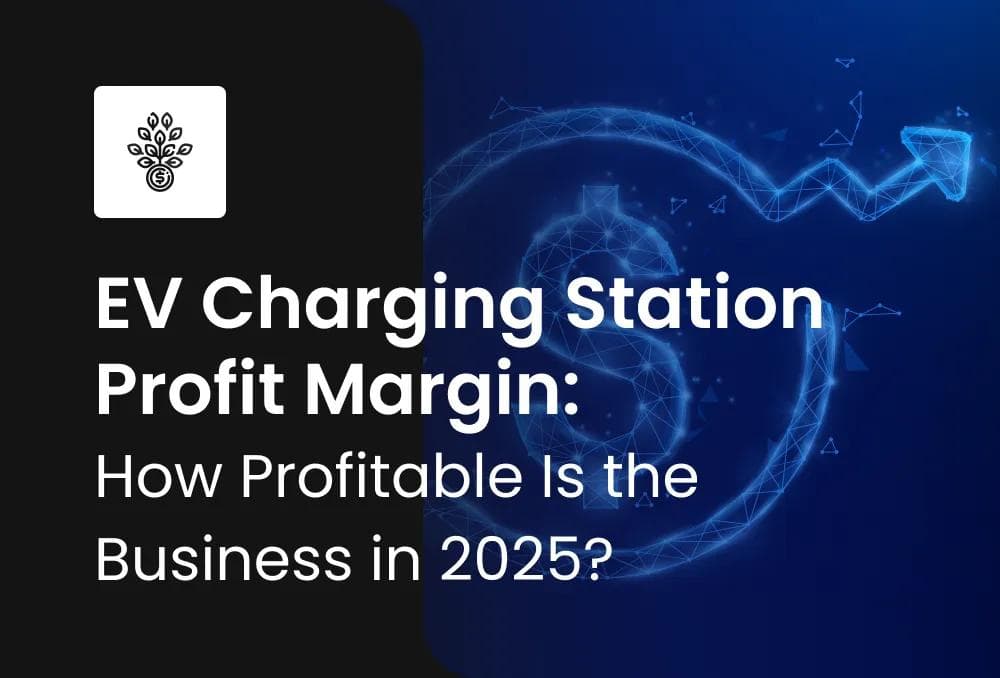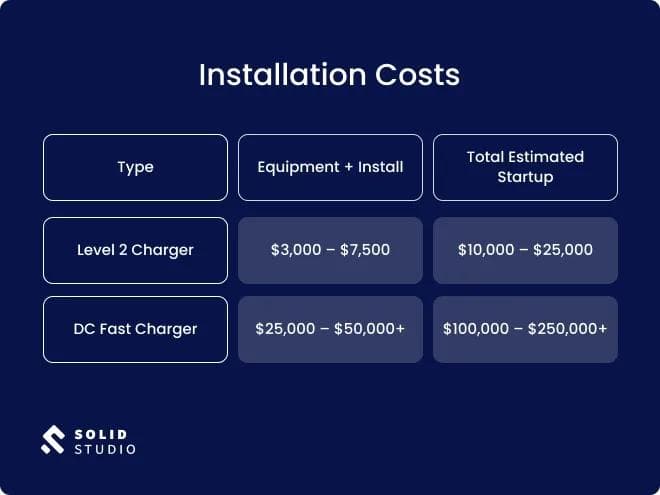Is running EV charging stations profitable?
If you've ever wondered about it, you're not alone. As electric vehicles become more common on the roads, a lot of business owners, landlords, and investors are starting to ask the same thing: how much money can you really make from owning a charging station?
This guide breaks down the real numbers behind the EV charging station profit margin: what it costs to get started in the EV market, what kind of income you can expect, and how long it might take to turn a profit. We’ll also cover the different ways EV stations make money, the role of Tesla in all this, and whether it’s worth the investment in 2025.
You’ll get clear answers to practical questions like:
- Is buying a charging station a good investment?
- How much does installing EV charging stations cost to start?
- Can you actually make money owning a Tesla charger?
If you're thinking about getting into the EV space, or just want to know if this is a business worth considering, this article will give you the facts, not the hype.
What is the EV charging station profit margin?
Profit margins for EV charging stations vary widely depending on location, charger type, and how the station is monetized. Nonetheless, the range typically falls between 10% and 30% net margin once up and running.
At the low end, public Level 2 EV chargers in low-traffic areas may struggle to break even, especially when factoring in maintenance, network fees, and electricity costs. On the high end, fast-charging (DCFC) stations located near highways or in urban centers can generate solid business profits, particularly when bundled with other services such as food, retail, or advertising.
What can make your EV charging stations profitable?
- Energy resale markup: Station owners buy electricity wholesale and resell it at a retail rate, often with a 20–50% markup.
- Utilization rate: EV chargers sitting idle make nothing. Long-term profitability hinges on usage volume.
- Demand charges: These peak-use penalties from utilities can significantly eat into margins if not managed carefully.
- Additional revenue streams: Some of the best-performing EV charging stations earn additional income from on-site retail, ads, or fleet contracts.
Example Breakdown (per charger, monthly):
- Revenue: $1,200–$2,500
- Energy cost: $400–$800
- Operational costs (maintenance + network fees): $150–$300
- Net profit: $300–$1,200 (approx. 15–30% margin)
In short, EV charging can be a profitable business, but only if you manage your costs, find the right location, and keep chargers busy. Treat it like a real business, not a passive asset.
Is the EV charging station business profitable?
Yes, but only under the right conditions. EV charging isn't a guaranteed cash cow, and like most infrastructure businesses, success depends on usage, location, and smart cost management.
What determines long-term profitability?
- EV charger type matters
- Level 2 EV chargers are cheaper to install but slower to charge. They work well in workplaces or residential areas with long dwell times.
- DC fast chargers (DCFC) are more expensive, but the charging speed is incomparable (minutes vs. hours), and command higher rates as a result.
- High-traffic areas win
EV chargers in busy commercial areas, near highways, or paired with retail often outperform those in remote or residential-only areas. The more cars flowing through, the faster you reach ROI. - Smart monetization
Stations that combine charging with other revenue streams (retail, ads, convenience stores) can maximize profitability more easily.
Realistic ROI outlook
Most profitable EV charging businesses report breakeven in 2–4 years for fast-charging stations, sometimes quicker with government grants or fleet deals. Level 2 stations may take longer, unless paired with a high-volume location or used to support a broader business strategy (like boosting foot traffic or tenant value).
So is it profitable? Yes, when treated like a business. Passive installs in low-use areas won’t cut it. But strategic deployments in smart locations with the right EV charging infrastructure can turn into scalable and steady revenue streams.
Revenue streams: How does EV charging infrastructure make money?
Most people think EV stations only make money by charging for, well, charging. But in reality, there are multiple revenue streams, and the most profitable stations stack them.
Energy resale (core revenue)
At the heart of every EV charging station is the simple business model: buy electricity at wholesale utility rates and sell it at a markup. Depending on your location and utility agreements, margins range from 20% to 50%.
But here’s the catch: long-term profitability hinges on volume. The more sessions per day, the more that markup matters.
Idle fees
Some networks charge drivers when they leave their car plugged in after it's fully charged. Station owners often get a cut of these fees, a small but passive income stream.
Advertising and screens
High-traffic chargers with digital displays can sell ad space to local businesses or brands. In some locations, this revenue can rival or even surpass charging fees.
Retail and amenity upsell
Many charging stations are installed outside cafes, convenience stores, or malls, either owned by the station operator or in partnership. Charging time = dwell time = opportunity to sell more coffee, snacks, or services.
5. Fleet and subscription contracts
B2B revenue is growing fast. Delivery companies, rideshare fleets, and municipalities often pay a monthly rate for priority access, maintenance guarantees, or volume pricing.
6. Charging-as-a-Service (CaaS)
Some operators offer their stations as a managed service. Landlords or businesses pay a flat fee to have stations installed, while the provider keeps the usage revenue.
The bottom line? Charging is just the beginning. The most successful EV station operators think like retailers and infrastructure providers, layering multiple income streams to drive profitability.
Startup operational costs and investment analysis
Installing EV chargers isn't cheap, but it’s also not out of reach for most small business owners or real estate investors. The cost depends heavily on the type of charger, site complexity, and local incentives.
Installation costs (ballpark averages):
These numbers include trenching, electrical upgrades, network integration, and permitting—all the behind-the-scenes work that most first-time investors overlook.
Ongoing operating costs (monthly)
- Electricity costs: $300–$1,000 per charger
- Network service fees: $50–$100
- Maintenance: $50–$150
- Insurance: Varies by provider and location
Government incentives can cut costs in half
Federal, state, and utility rebates can cover up to 80% of installation costs, particularly for DC fast chargers in underserved areas or along key transit corridors.
What’s the ROI?
- Level 2 stations: 3–5 years payback (if well-located and consistently used)
- Fast chargers: 2–3 years, especially with subsidies or fleet deals
- Profit margins grow substantially once CapEx is recouped
Bottom Line: This is a long-game investment, not a quick flip. But for landlords, developers, or forward-looking entrepreneurs, EV charging can be a strong infrastructure play, especially when paired with existing foot traffic or real estate.
Can you make money owning a Tesla charging station?
Tesla has one of the most recognized charging networks in the world, but that doesn’t mean just anyone can set one up and profit from it. There are two main routes to “owning” Tesla charging infrastructure, and they operate very differently from standard EV charging business models.
Option 1: Tesla Destination Charging Partner
Tesla’s Destination Charging Program lets hotels, restaurants, and property owners install Level 2 Tesla Wall Connectors on their premises, but it’s not a money-maker.
- No user fees: Most of these chargers are free for Tesla drivers to use.
- No direct income: You can’t charge per kWh or by session.
- Why do it? These stations are meant to attract Tesla owners to your location, not generate revenue.
Option 2: Tesla Supercharger partnerships
Tesla has begun opening its Supercharger network to other EV brands and third-party site owners. This is where things start to get interesting:
- Tesla covers the hardware (in many cases)
- Site hosts provide the space and pay for utility upgrades
- Revenue sharing depends on location and deal terms, not yet widely disclosed
So, can you make money owning a Tesla charging station? Only if you’re part of a Supercharger partner site, and even then, profitability depends on Tesla’s control, traffic volume, and contractual terms.
Pro Tip: If you want full control over pricing, user access, and profit strategy, non-Tesla DC fast chargers give you more flexibility and ownership upside.
Annual revenue estimates
So, how much does an EV charging station actually make in a year? It all depends on charger type, utilization rate, electricity pricing, and location. But here’s a general breakdown to help set realistic expectations.
Level 2 DC chargers (Moderate traffic, urban setting)
- Sessions/day: 5–10
- Avg revenue/session: $3–$5
- Monthly gross: $500–$1,500
- Yearly revenue: $6,000–$18,000 per charger
- Net profit: Typically $1,000–$5,000/year, after costs
These are ideal for residential buildings, offices, or retail centers where EV owners stay parked for a few hours.
DC fast chargers (High-traffic, highway, or commercial zone)
- Sessions/day: 10–30
- Avg revenue/session: $7–$15
- Monthly gross: $3,000–$12,000
- Yearly revenue: $36,000–$144,000 per charger
- Net profit: $10,000–$40,000/year, depending on demand and demand charges
Fast chargers dominate in areas with short dwell times, high turnover, or commercial fleets.
Key variable: Utilization rate
Profitability scales with usage. An EV charger that sees only 1–2 sessions/day might never break even. But once you hit consistent 30–50% utilization, margins grow steadily.
Summary:
An EV charging station can make anywhere from a few thousand to over $40,000 per year, but only if it’s placed well, maintained efficiently, and marketed to attract regular use.
Business opportunities in 2025 and beyond
The EV charging industry is no longer just about installing a charger and hoping drivers show up. In 2025, it's evolving into a broader ecosystem with new verticals, smarter tech, and fresh ways to generate revenue.
B2B charging for fleets
Delivery services, rideshare companies, and even public transit systems need dedicated charging solutions. Operators who provide consistent uptime and fast-charging access can lock in long-term contracts.
Example: A fleet of 20 electric vehicles charging nightly could guarantee a baseline of usage that dwarfs individual drivers.
Underserved markets
Many suburban and rural areas are still EV dead zones. Installing EV chargers where others haven’t, especially near highways or regional shopping centers, creates a first-mover advantage.
Bonus: Government incentives are often stronger in these areas.
Charging + retail integration
Traditional gas stations aren’t just fueling stops; they’re convenience hubs. The same logic applies to EVs. DC charging stations paired with coffee shops, mini-marts, or restaurants see longer dwell times and higher basket sizes.
Think “charge and shop” instead of “plug and wait.”
4. Workplace & Multifamily Installations
Employers and landlords are under pressure to provide EV charging, and most don’t want to deal with logistics. This opens up recurring revenue for operators who offer Charging-as-a-Service (CaaS) packages.
You handle everything; they just pay a monthly fee.
5. Smart grid and energy storage synergies
With V2G (Vehicle-to-Grid) and battery storage tech, chargers can do more than sell energy; they can manage it. This opens the door to load balancing, peak shaving, and utility rebates.
Advanced operators will build not just charging stations, but energy assets.
Bottom line: In 2025, the best EV charging opportunities go beyond hardware. They’re about solving pain points for fleets, landlords, and consumers, while tapping into bigger trends like sustainability, energy independence, and retail experience.
The 80% rule and its impact on revenue
If you've spent time around EV drivers or forums, you’ve probably heard the phrase: “Only charge up to 80%.” This isn’t just a tip for battery health; it directly affects how long cars occupy chargers and how much money operators make.
What is the 80% rule?
Most EV manufacturers and charging apps recommend drivers charge to no more than 80% for daily use. Why?
- Charging slows dramatically after 80%
- It preserves EV battery lifespan
- It frees up chargers for others
Why it matters for station owners
- Session turnover increases
When users stop at 80%, chargers become available faster. More sessions = more revenue, especially at fast-charging sites where dwell time is critical. - Reduced idle time
Long charging times reduce utilization rates. If a charger is blocked by a car slowly crawling from 80% to 100%, you’re losing potential transactions. - Driver satisfaction
Faster turnover keeps wait times low and reviews high, both essential if your business relies on repeat use or fleet clients.
But there’s a catch
Drivers aiming for road trips or a full battery might ignore the 80% guideline. That’s where idle fees or time-based pricing come into play, nudging users to unplug sooner and keep your infrastructure moving.
Key takeaway:
The 80% rule is about maximizing charger uptime and squeezing more profit out of every hour your station is live.
Final verdict: Is it worth starting a charging station business to make money?
Here’s the honest answer: Yes, but only if you approach it like a real business, not a passive investment.
EV charging isn’t a “set it and forget it” opportunity. The stations that turn a consistent profit are located in high-traffic areas, optimized for turnover, and backed by smart energy management and revenue layering.
Who should consider it?
- Property owners: Boost tenant value and attract traffic
- Retail businesses: Drive footfall and increase dwell time
- Fleet operators: Cut fueling costs and improve logistics
- Energy entrepreneurs: Build infrastructure and tap into B2B contracts
When it’s not a good fit
- You expect fast, hands-off returns
- You’re in a low-traffic or rural area with no partnerships
- You won’t actively monitor pricing, usage, or maintenance
Bottom line of the EV charging station business
A well-placed, well-managed charging station can earn $5,000–$40,000+ per year in profit, depending on scale and model. But just like any infrastructure investment, returns grow with effort, strategy, and smart location choices.
If you’re ready to treat EV charging as a long-term, growth-focused business, it’s absolutely worth it.
Bonus: Is it still free to charge an electric car?
Short answer: Sometimes, but it’s getting rare.
Where charging electric vehicles is still free
- Workplaces: Some employers offer it as an incentive
- Hotels and resorts: Many Tesla Destination Chargers fall into this category
- Public institutions: City governments, libraries, or universities may offer charging for free to encourage EV adoption
But these are the exception, not the norm.
Why is charging for free fading out?
- Electricity isn’t free for the station owner
- Maintenance and network fees add up
- More EVs = higher usage = less incentive to subsidize energy
In most cases, “free” charging today is a loss leader used to attract customers to a business or location where they’ll spend money on other things.
What it means for station owners
Unless you’re offering charging as a perk to boost another business (like retail or hospitality), giving it away for free likely isn’t sustainable. Even a modest per-session fee helps cover your costs and signals real value.
Takeaway: Free EV charging still exists, but for business-minded operators, monetizing sessions is the path to profitability.
Ready to build a profitable charging business?
EV charging can be a great business, but only if you get the fundamentals right. It’s not about buzzwords or future-proofing. Think: location, usage, margins, and whether your setup makes money.
That’s where Solidstudio comes in. With our software, we help you turn stations into real businesses. Whether you’re starting from scratch or scaling a network, we’ll work with you to make sure the tech, data, and operations serve your bottom line.
Wanna build something that works and earns? Just let us know.




